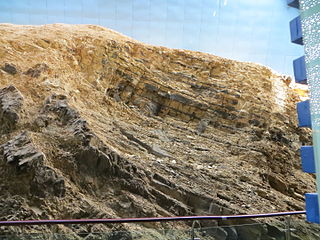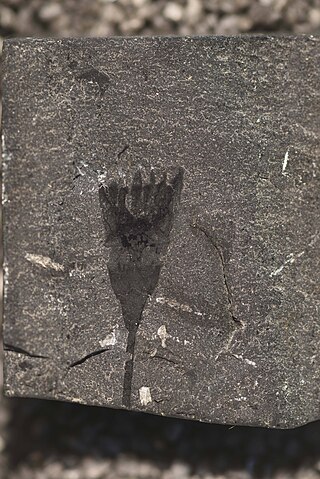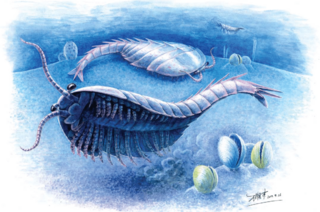
Lobopodians are members of the informal group Lobopodia, or the formally erected phylum Lobopoda Cavalier-Smith (1998). They are panarthropods with stubby legs called lobopods, a term which may also be used as a common name of this group as well. While the definition of lobopodians may differ between literatures, it usually refers to a group of soft-bodied, marine worm-like fossil panarthropods such as Aysheaia and Hallucigenia. However, other genera like Kerygmachela and Pambdelurion are often referred to as “gilled lobopodians”.

Vetulicolia is a group of bilaterian marine animals encompassing several extinct species from the Cambrian, and possibly Ediacaran, periods. As of 2023, the majority of workers favor placing Vetulicolians in the stem group of the Chordata, but some continue to favor a more crownward placement as a sister group to the Tunicata. It was initially erected as a monophyletic clade with the rank of phylum in 2001, with subsequent work supporting its monophyly. However, more recent research suggests that vetulicolians may be paraphyletic and form a basal evolutionary grade of stem chordates.

Ctenophora comprise a phylum of marine invertebrates, commonly known as comb jellies, that inhabit sea waters worldwide. They are notable for the groups of cilia they use for swimming, and they are the largest animals to swim with the help of cilia.

The Maotianshan Shales (帽天山页岩) are a series of Early Cambrian sedimentary deposits in the Chiungchussu Formation, famous for their Konservat Lagerstätten, deposits known for the exceptional preservation of fossilized organisms or traces. The Maotianshan Shales form one of some forty Cambrian fossil locations worldwide exhibiting exquisite preservation of rarely preserved, non-mineralized soft tissue, comparable to the fossils of the Burgess Shale of British Columbia, Canada. They take their name from Maotianshan Hill in Chengjiang County, Yunnan Province, China.
Myllokunmingia is a genus of basal chordate from the Lower Cambrian Maotianshan shales of China 518 mya and is thought to be a vertebrate, although this is not conclusively proven. The type species M. fengjiaoa is 28 mm long and 6 mm high. It is among the oldest possible craniates, found in the lower Cambrian Chengjiang. It appears to have a skull and skeletal structures made of cartilage. There is no sign of biomineralization of the skeletal elements. The holotype was found in the Yuanshan member of the Qiongzhusi Formation in the Eoredlichia Zone near Haikou at Ercaicun, Kunming City, Yunnan, China. Some researchers have considered the other primitive chordate Haikouichthys to be synonymous with this taxon, but subsequent studies led by the British paleontologist Simon Conway Morris identified both genera to be distinct, separate taxa on the basis of different gill arrangement, the absence of branchial rays in Myllokunmingia and the myomeres having a more acute shape in Haikouichthys.

Fasciculus vesanus is an extinct species of stem-group ctenophores known from the Burgess Shale of British Columbia, Canada. It is dated to 515 to 505 million years ago and belongs to middle Cambrian strata.

Vetulicola is an extinct genus of marine animal discovered from the Cambrian of China. It is the eponymous member of the enigmatic phylum Vetulicolia, which is of uncertain affinities but may belong to the deuterostomes. The name was derived from Vetulicola cuneata, the first species described by Hou Xian-guang in 1987 from the Lower Cambrian Chiungchussu Formation in Chengjiang, China.

Anomalocarididae is an extinct family of Cambrian radiodonts, a group of stem-group arthropods.

Dinomischusis an extinct genus of stalked filter-feeding animals within the Cambrian period, with specimens known from the Burgess Shale and the Maotianshan Shales. While long of uncertain affinities, recent studies have suggested it to be a stem-group ctenophore.
The genus Trigoides is known from fossils from the Chengjiang Lagerstätte. It is proposed to be a type of ctenophore. A phylogenetic study of Cambrian stem-group ctenophores recovered Trigoides in Scleroctenophora, along with Galeactena, Maotianoascus, Thaumactena, Batofasciculus and Gemmactena.

Vetulicola cuneata is a species of extinct marine animal from the Early Cambrian Chengjiang biota of China. It was described by Hou Xian-guang in 1987 from the Lower Cambrian Chiungchussu Formation, and became the first animal under an eponymous phylum Vetulicolia.
Eolympia is interpreted as an extinct monospecific genus of sea anemone or dinomischid ctenophore which existed in what is now Ningqiang, Shaanxi Province, China during the lower Cambrian period. Its fossils have been recovered from the Kuanchuanpu Formation. The pedicle is long, suggesting the animal engaged in sexual intercourse, though marked perforations imply that reproduction by transverse fission was also quite likely as a more primitive backup.

Siphusauctum is an extinct genus of filter-feeding animals that lived during the Middle Cambrian about 510 million years ago.

Cotyledion tylodes is an extinct, stalked filter-feeder known from the Chengjiang lagerstatten. The living animal reached a couple of centimetres in height, and bore a loose scleritome of ovoid sclerites. Its interpretation has been controversial, but it is currently thought to be a member of the Entoprocta stem group.

Xianguangia is a soft-bodied sea anemone-like fossil animal from the Chengjiang Biota of China.

Scleroctenophora is an extinct class of stem group ctenophores, known from the Chinese Maotianshan shales of Yunnan. It is dated to Cambrian Stage 3 and belongs to late Early Cambrian strata. Scleroctenophorans are easily distinguished from other ctenophores by the presence of an internal skeleton that supports the body.

Hymenocarina is an order of extinct arthropods known from the Cambrian. They possess bivalved carapaces, typically with exposed posteriors. Members of the group are morphologically diverse and had a variety of ecologies, including as filter feeders and as predators. Recent research has generally considered them to be stem or crown group members of Mandibulata, due to the presence of mandibles in some species.

Fuxianhuiida is an extinct clade of arthropods from the Cambrian of China. All currently known species are from Cambrian Series 2 aged deposits in Yunnan Province, including the Chengjiang biota. Although historically suggested to be members of the arthropod stem group recent research has suggested that they may be closely related to mandibulates. Many specimens are known with exceptional soft tissue preservation, including preserved guts and neural tissue, which given their basal phylogenetic position makes them important in understanding the evolution of Arthropoda as a whole. They reach a size of up to 15 cm, and are interpreted as benthic predators and scavengers. The Fuxianhuiid exoskeleton is unmineralised, and the number of tergites ranges from 15 to over 40. The cephalon is covered by a head shield and contains stalked eyes connected by the anterior sclerite, antennae, a butterfly shaped hyposome and a posterior facing mouth. Fuxianhuiids possess specialized post-antennal appendages with serrated edges used for food processing. The presence of gnathobases in members of Chengjiangocardidae suggests that they were capable of durophagy. In most Fuxianhuiids, the thorax tergites narrow posteriorly, terminating in either a swimming paddle or paired flukes with a tail spine. In members of Fuxianhuiidae the thorax is divided into two sections, the anterior wide opisthothorax and the posterior narrow limbless tail-like abdomen.

This is a list of the biota of the Burgess Shale, a Cambrian lagerstätte located in Yoho National Park in Canada.

Daihua sanqiong is a possible ancestor of comb jellies. It was a sessile relative to comb jellies. It had combs with cilia just like modern day comb jellies.
















